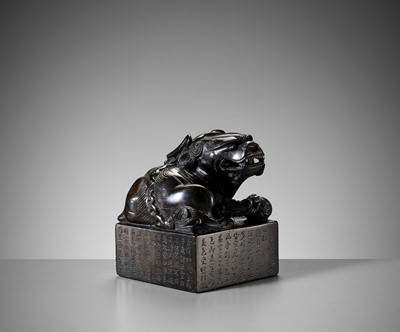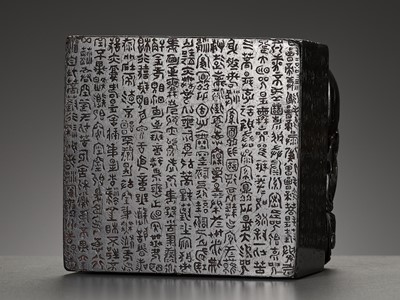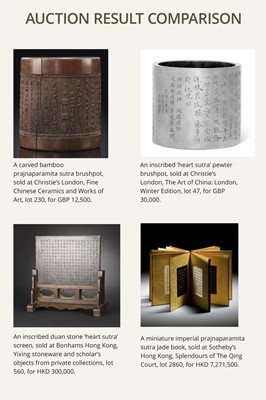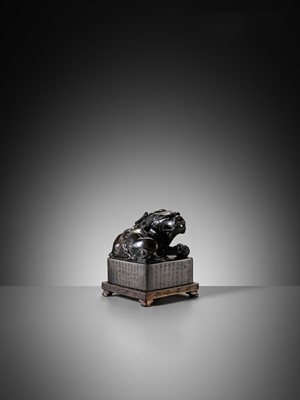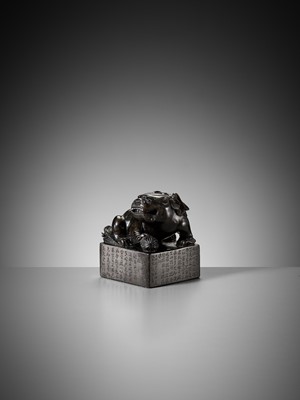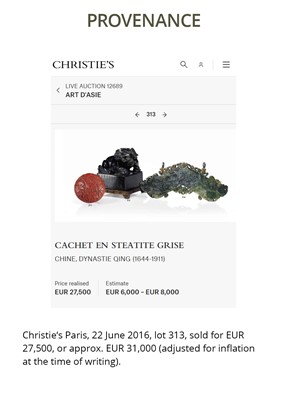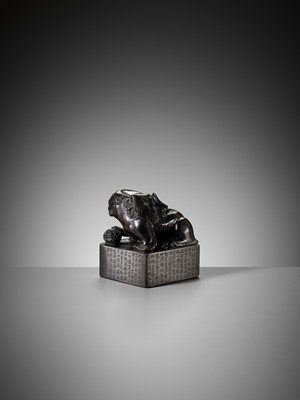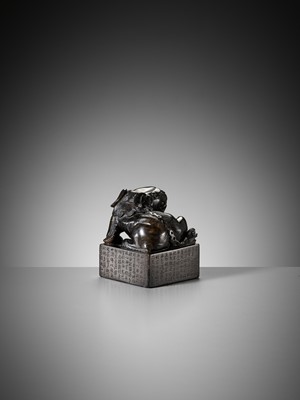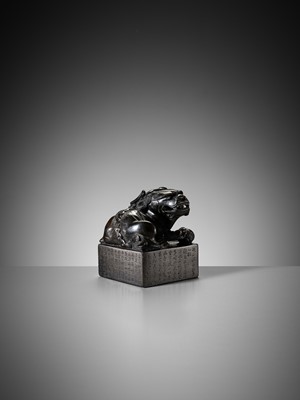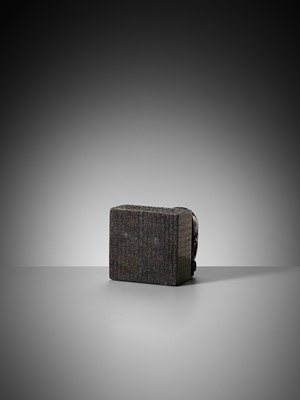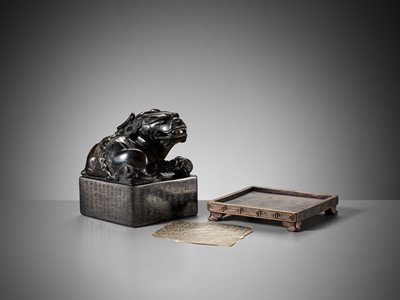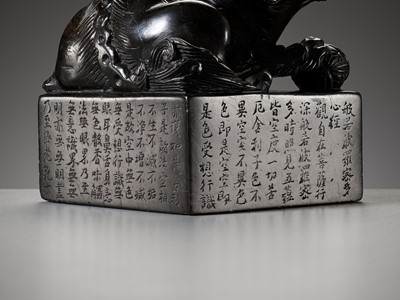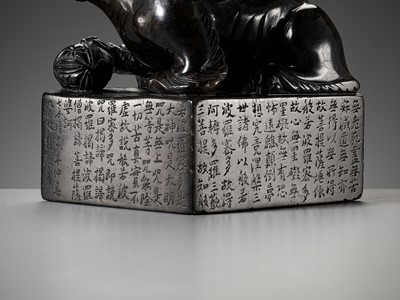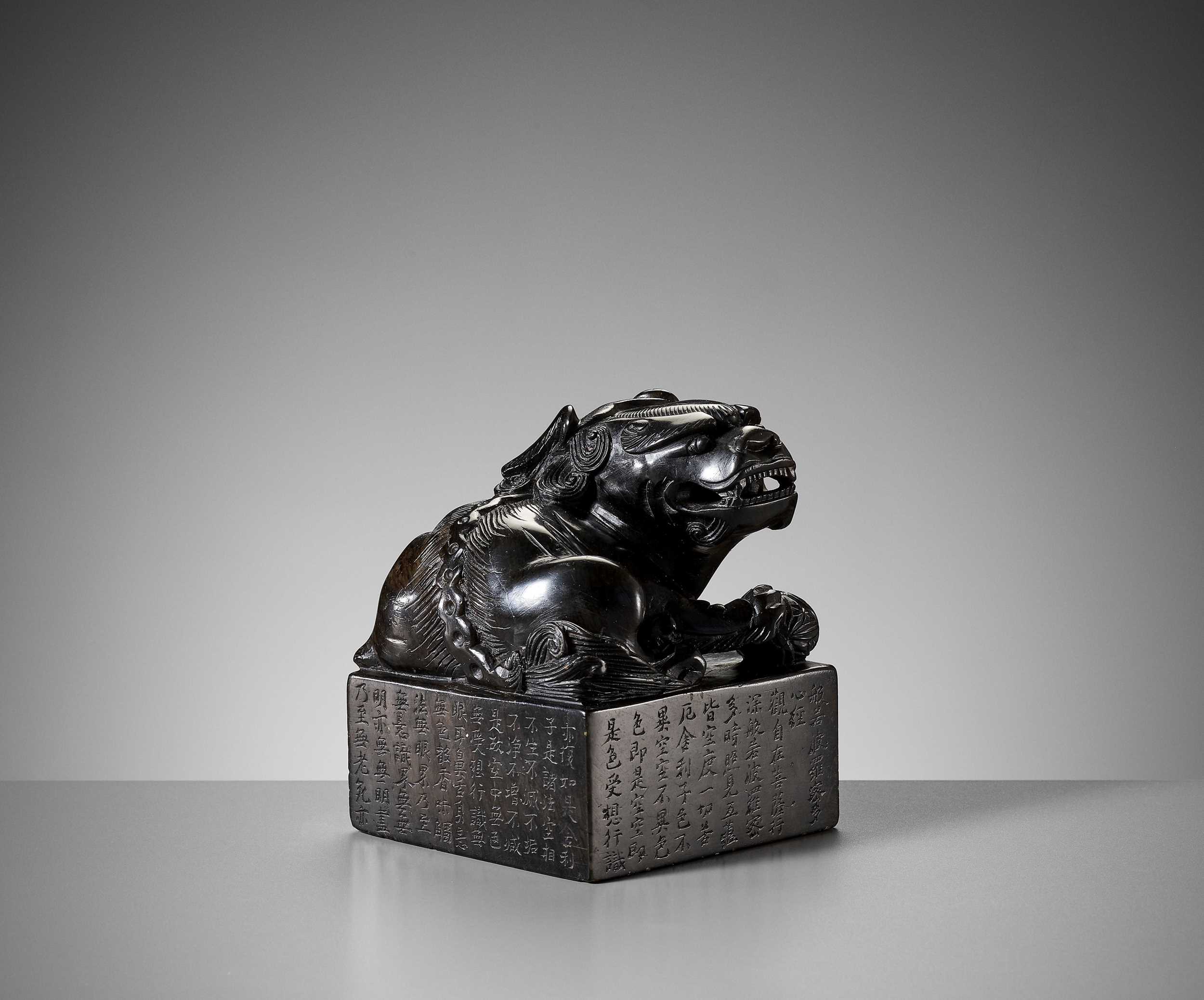29th Sep, 2022 13:00
DAY 1 - TWO-DAY AUCTION - Fine Chinese Art / 中國藝術集珍 / Buddhism & Hinduism
25
A LARGE ‘BUDDHIST LION’ SEAL, INSCRIBED WITH THE HEART SUTRA, QING DYNASTY
清代《般若波羅蜜多心經》獅鈕印
Sold for €9,750
including Buyer's Premium
China, 1644-1912, probably Qianlong, 1736-1795 (see expert’s note). The massive square seal is surmounted by a finely carved recumbent Buddhist lion, its head turned to the right, the tail swept to the left, and the right foot resting on a brocade ball. The ferocious face is finely detailed with its mouth slightly agape to reveal sharp fangs holding a ball. The opaque soapstone is of a dark-brown, almost jet-black tone with scattered beige inclusions.
Inscriptions: The seal face incised in zhuan style with the Heart Sutra, the four sides showing the same text written in kai style. With apocryphal signature ‘Wen Peng’ and date of the 16th year of the Jiajing reign (corresponding to 1537). The inscription has an overall length of more than 500 neatly incised characters!
Provenance: From the property of a French noble family, the collection formed by the owner's great-grandfather from the late 19th century to the early 20th century. Christie's Paris, 22 June 2016, lot 313, sold for EUR 27,500, or approx. EUR 31,000 (adjusted for inflation at the time of writing). A noted private collection, acquired from the above.
Condition: Very good condition with fine old wear, few nicks and shallow surface scratches, minuscule chips to the edges. With a naturally grown patina and an unctuous feel overall, clearly the result of centuries-long handling.
Weight: 1,412 g (incl. base) and 1,374 g (excl. base)
Dimensions: Height 11.7 cm (incl. base) and 10.6 cm (excl. base)
With a finely carved wood base supported on four short feet and with key-fret bands neatly incised to the sides, as well as an old rubbing of the seal face on paper. (3)
The inscribed text is known as the Prajnaparamita sutra, or Heart Sutra, which was translated into Chinese in the 7th century by the pilgrim monk Xuanzang on the orders of the Emperor Gaozong (reigned 649-683 AD). One of the principal scriptures of the Madhyamika school of Buddhism founded by the great Buddhist philosopher Nagarjuna (c. 100-200 BC), the Heart Sutra expounds that through true wisdom, one may realize the emptiness of this world and so achieve Enlightenment.
The Heart Sutra, propagating total denial of the reality of the phenomenal world, is one of the most important Mahayana texts and became a popular script for copying, probably partly due to its brevity. Such copying had the dual function of serving as a calligraphic exercise and representing an act of devotion.
Wen Peng (1498-1573), a famous seal carver, was the eldest son of the artist Wen Zhengming. He was a native of Changzhou (Suzhou), Jiangsu, and the originator of the Sanqiao School, the first literati seal carving school.
Expert’s note: The Qianlong Emperor was a devout Buddhist and is known to have himself copied the Heart Sutra countless times. He also ordered various objects - including seals - to be carved with the text, some of these bearing apocryphal dates as reference to earlier reigns. The Jiajing Emperor, however, was a devoted Daoist, morphing somewhat into a fanatic after an assassination attempt in 1542. The date on the present seal - 1537 - points to a time shortly before this event, when the Emperor already favored princes who were devout Daoists, granting the most fervent followers amongst them gifts and titles, therefore actively suppressing Buddhism. For these reasons, it seems more likely that the present seal was carved during the Qianlong era, and not in the Jiajing period, despite the fact that experts from Sotheby’s London have dated the present seal to the Ming Dynasty.
清代《般若波羅蜜多心經》獅鈕印
中國, 1644-1912年,可能為乾隆時期(1736-1795年,見專家注釋)。方形印章上有一頭雕刻精美的臥獅,它的頭右轉,尾巴左掃,右腳踩在一個錦球上。眼睛圓鼓,張開的嘴巴裏露出鋒利的尖牙。不透明的皂石呈深棕色,幾乎是烏黑的色調,帶有散落的米色内沁。
款識:印章面篆書《般若波羅蜜多心經》,四側面楷書同樣文字。文鵬款,嘉靖十六年 (1537年)。全文500多個字。
來源:法國貴族家族收藏,收藏由現主人的曾祖父建立於十九世紀末至二十世紀初;巴黎佳士得,2016年6月22日, lot 313, 售價27,500, 相當於現在的 EUR 31,000;知名私人收藏,購於上述拍賣。
品相:品相極好,有磨損,少量刻痕和表面淺劃痕,邊緣有微小的磕損。自然生長的光澤和包漿。
重量:1,412 克 (含底座) 與 1,374 克 (不含底座)
尺寸:高11.7 厘米(含底座) 與10.6 厘米(不含底座)
雷紋四足木底座。(3)
《般若波羅蜜多心經》於公元七世紀由唐僧玄奘奉唐高宗(公元 649-683 年在位)之命翻譯成中文。 《心經》是偉大的佛教哲學家龍樹菩薩(約公元前 100-200 年)創立的中觀佛教派的主要經典之一,圓滿究竟、全面地、徹底地理解宇宙真實與原理的智慧。
《心經》宣傳完全否定現象世界的真實性,是最重要的大乘經典之一,並成為一種流行的抄寫本,部分原因可能是它的簡潔性。這種抄寫具有作為書法練習和供養的雙重功能。
專家注釋:乾隆帝是一位虔誠的佛教徒,曾無數次抄寫《心經》。他還下令將各種物品(包括印章)篆刻。然而,嘉靖皇帝是一位虔誠的道士,1542 年經歷一次暗殺。現在的印章上的日期 - 1537 年 - 指向這一事件前不久的時間,當時皇帝已經偏愛虔誠的王子與道士們,鎮壓佛教。由於這些原因,儘管倫敦蘇富比的專家已經將現在的印章定為明朝,但現在的印章似乎更有可能是在乾隆時期而不是在嘉靖年間雕刻的。
China, 1644-1912, probably Qianlong, 1736-1795 (see expert’s note). The massive square seal is surmounted by a finely carved recumbent Buddhist lion, its head turned to the right, the tail swept to the left, and the right foot resting on a brocade ball. The ferocious face is finely detailed with its mouth slightly agape to reveal sharp fangs holding a ball. The opaque soapstone is of a dark-brown, almost jet-black tone with scattered beige inclusions.
Inscriptions: The seal face incised in zhuan style with the Heart Sutra, the four sides showing the same text written in kai style. With apocryphal signature ‘Wen Peng’ and date of the 16th year of the Jiajing reign (corresponding to 1537). The inscription has an overall length of more than 500 neatly incised characters!
Provenance: From the property of a French noble family, the collection formed by the owner's great-grandfather from the late 19th century to the early 20th century. Christie's Paris, 22 June 2016, lot 313, sold for EUR 27,500, or approx. EUR 31,000 (adjusted for inflation at the time of writing). A noted private collection, acquired from the above.
Condition: Very good condition with fine old wear, few nicks and shallow surface scratches, minuscule chips to the edges. With a naturally grown patina and an unctuous feel overall, clearly the result of centuries-long handling.
Weight: 1,412 g (incl. base) and 1,374 g (excl. base)
Dimensions: Height 11.7 cm (incl. base) and 10.6 cm (excl. base)
With a finely carved wood base supported on four short feet and with key-fret bands neatly incised to the sides, as well as an old rubbing of the seal face on paper. (3)
The inscribed text is known as the Prajnaparamita sutra, or Heart Sutra, which was translated into Chinese in the 7th century by the pilgrim monk Xuanzang on the orders of the Emperor Gaozong (reigned 649-683 AD). One of the principal scriptures of the Madhyamika school of Buddhism founded by the great Buddhist philosopher Nagarjuna (c. 100-200 BC), the Heart Sutra expounds that through true wisdom, one may realize the emptiness of this world and so achieve Enlightenment.
The Heart Sutra, propagating total denial of the reality of the phenomenal world, is one of the most important Mahayana texts and became a popular script for copying, probably partly due to its brevity. Such copying had the dual function of serving as a calligraphic exercise and representing an act of devotion.
Wen Peng (1498-1573), a famous seal carver, was the eldest son of the artist Wen Zhengming. He was a native of Changzhou (Suzhou), Jiangsu, and the originator of the Sanqiao School, the first literati seal carving school.
Expert’s note: The Qianlong Emperor was a devout Buddhist and is known to have himself copied the Heart Sutra countless times. He also ordered various objects - including seals - to be carved with the text, some of these bearing apocryphal dates as reference to earlier reigns. The Jiajing Emperor, however, was a devoted Daoist, morphing somewhat into a fanatic after an assassination attempt in 1542. The date on the present seal - 1537 - points to a time shortly before this event, when the Emperor already favored princes who were devout Daoists, granting the most fervent followers amongst them gifts and titles, therefore actively suppressing Buddhism. For these reasons, it seems more likely that the present seal was carved during the Qianlong era, and not in the Jiajing period, despite the fact that experts from Sotheby’s London have dated the present seal to the Ming Dynasty.
清代《般若波羅蜜多心經》獅鈕印
中國, 1644-1912年,可能為乾隆時期(1736-1795年,見專家注釋)。方形印章上有一頭雕刻精美的臥獅,它的頭右轉,尾巴左掃,右腳踩在一個錦球上。眼睛圓鼓,張開的嘴巴裏露出鋒利的尖牙。不透明的皂石呈深棕色,幾乎是烏黑的色調,帶有散落的米色内沁。
款識:印章面篆書《般若波羅蜜多心經》,四側面楷書同樣文字。文鵬款,嘉靖十六年 (1537年)。全文500多個字。
來源:法國貴族家族收藏,收藏由現主人的曾祖父建立於十九世紀末至二十世紀初;巴黎佳士得,2016年6月22日, lot 313, 售價27,500, 相當於現在的 EUR 31,000;知名私人收藏,購於上述拍賣。
品相:品相極好,有磨損,少量刻痕和表面淺劃痕,邊緣有微小的磕損。自然生長的光澤和包漿。
重量:1,412 克 (含底座) 與 1,374 克 (不含底座)
尺寸:高11.7 厘米(含底座) 與10.6 厘米(不含底座)
雷紋四足木底座。(3)
《般若波羅蜜多心經》於公元七世紀由唐僧玄奘奉唐高宗(公元 649-683 年在位)之命翻譯成中文。 《心經》是偉大的佛教哲學家龍樹菩薩(約公元前 100-200 年)創立的中觀佛教派的主要經典之一,圓滿究竟、全面地、徹底地理解宇宙真實與原理的智慧。
《心經》宣傳完全否定現象世界的真實性,是最重要的大乘經典之一,並成為一種流行的抄寫本,部分原因可能是它的簡潔性。這種抄寫具有作為書法練習和供養的雙重功能。
專家注釋:乾隆帝是一位虔誠的佛教徒,曾無數次抄寫《心經》。他還下令將各種物品(包括印章)篆刻。然而,嘉靖皇帝是一位虔誠的道士,1542 年經歷一次暗殺。現在的印章上的日期 - 1537 年 - 指向這一事件前不久的時間,當時皇帝已經偏愛虔誠的王子與道士們,鎮壓佛教。由於這些原因,儘管倫敦蘇富比的專家已經將現在的印章定為明朝,但現在的印章似乎更有可能是在乾隆時期而不是在嘉靖年間雕刻的。
Zacke Live Online Bidding
Our online bidding platform makes it easier than ever to bid in our auctions! When you bid through our website, you can take advantage of our premium buyer's terms without incurring any additional online bidding surcharges.
To bid live online, you'll need to create an online account. Once your account is created and your identity is verified, you can register to bid in an auction up to 12 hours before the auction begins.
Intended Spend and Bid Limits
When you register to bid in an online auction, you will need to share your intended maximum spending budget for the auction. We will then review your intended spend and set a bid limit for you. Once you have pre-registered for a live online auction, you can see your intended spend and bid limit by going to 'Account Settings' and clicking on 'Live Bidding Registrations'.
Your bid limit will be the maximum amount you can bid during the auction. Your bid limit is for the hammer price and is not affected by the buyer’s premium and VAT. For example, if you have a bid limit of €1,000 and place two winning bids for €300 and €200, then you will only be able to bid €500 for the rest of the auction. If you try to place a bid that is higher than €500, you will not be able to do so.
Online Absentee and Telephone Bids
You can now leave absentee and telephone bids on our website!
Absentee Bidding
Once you've created an account and your identity is verified, you can leave your absentee bid directly on the lot page. We will contact you when your bids have been confirmed.
Telephone Bidding
Once you've created an account and your identity is verified, you can leave telephone bids online. We will contact you when your bids have been confirmed.
Classic Absentee and Telephone Bidding Form
You can still submit absentee and telephone bids by email or fax if you prefer. Simply fill out the Absentee Bidding/Telephone bidding form and return it to us by email at office@zacke.at or by fax at +43 (1) 532 04 52 20. You can download the PDF from our Upcoming Auctions page.
How-To Guides
How to Create Your Personal Zacke Account
How to Register to Bid on Zacke Live
How to Leave Absentee Bids Online
How to Leave Telephone Bids Online
中文版本的操作指南
创建新账号
注册Zacke Live在线直播竞拍(免平台费)
缺席投标和电话投标
Third-Party Bidding
We partner with best-in-class third-party partners to make it easy for you to bid online in the channel of your choice. Please note that if you bid with one of our third-party online partners, then there will be a live bidding surcharge on top of your final purchase price. You can find all of our fees here. Here's a full list of our third-party partners:
- 51 Bid Live
- EpaiLive
- ArtFoxLive
- Invaluable
- LiveAuctioneers
- the-saleroom
- lot-tissimo
- Drouot
Please note that we place different auctions on different platforms. For example, in general, we only place Chinese art auctions on 51 Bid Live.
Bidding in Person
You must register to bid in person and will be assigned a paddle at the auction. Please contact us at office@zacke.at or +43 (1) 532 04 52 for the latest local health and safety guidelines.
